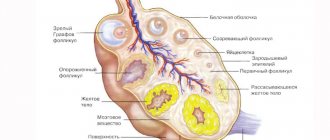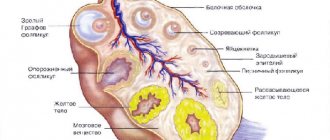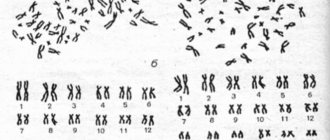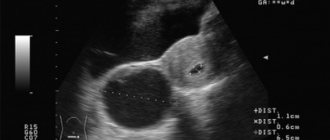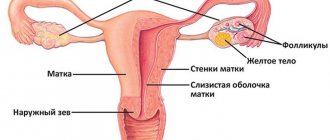The cystic body, which is attached to the left ovary and has a benign nature of its development, is a functional pathology and, according to the medical classification of diseases, is a moderately common disease today. It is not surprising that questions like “corpus luteum cyst of the left ovary, what is it” are catching up in popularity with questions about nutrition and diets. But in reality: what is a corpus luteum cyst of the left ovary? Let's talk about this anomaly in detail.
Corpus luteum cyst of the left ovary, what is it from a developmental point of view?
From a developmental point of view, this type of pathology refers to formations that are formed as a result of a non-functioning follicle. Ailments of this type include follicular ovarian cysts, the development of which is also associated with random or genetically determined deformation of the follicle or corpus luteum during menstruation and the ovulation period.
The capsule of the corpus luteum cyst of the left ovary is filled with a clear or yellow serous fluid. There are no impurities of blood or harmful harmful substances and microorganisms in it, unlike, for example, a hemorrhagic ovarian cyst. In some cases, the cyst of the left ovary of the corpus luteum, a photo of which is shown below, may be deformed as a result of mechanical or biological damage and contain a certain amount of pathogenic elements, which, during the development of the cyst, provoke adverse reactions and cause the appearance of somatic symptoms and diseases.
In the context of the question “what is a corpus luteum cyst of the left ovary?”, we note: this disease occurs today in approximately 3% of women of reproductive age. Women of mature age who postpone pregnancy and do not give birth until the age of 30 are most susceptible to this disease. The size of the deformed gland of the corpus luteum does not exceed 5-9 centimeters.
What's the prognosis?
It is noteworthy that the largest percentage of such benign formations is recorded mainly in the bodies of women who are pregnant or planning pregnancy. This phenomenon of signs of a corpus luteum cyst of the left ovary is due to the fact that during the formation of the placenta or hormonal therapy to stimulate ovulation, such a tumor is formed in order to replace the luteal gland and secrete hormones necessary to maintain the tone of the uterus and the proper consolidation of the fetus.
If an ovarian luteal cyst develops in a woman who is not pregnant, its features may differ and be expressed by more pathogenic symptoms or manifestations. In both cases, the corpus luteum cyst, most often, regresses on its own and disappears from the body over several months, without exerting a pathogenic effect on the tissues and appendages of the ovaries during its development and growth.
A tumor becomes problematic if it has been put under pressure by a growing uterus or side diseases.
What is a corpus luteum cyst with hemorrhage of the left ovary? The affected cyst can become deformed, fill with toxic fluid, and provoke the appearance of many additional symptoms and diseases. It is worth noting that a benign tumor of the corpus luteum most often develops pathogenically if it is present in a woman’s body: IMPORTANT TO KNOW!
- sexually transmitted infections;
- bacterial infections;
- HIV;
- problems or diseases of the endocrine system;
- blood diseases;
- gynecological inflammatory processes.
Symptoms
All processes associated with the formation and pathological growth of the formation are practically asymptomatic - usually it is possible to detect a cyst only during a routine examination by a gynecologist or ultrasound. But sometimes the expectant mother may feel slight discomfort and pain in the lower abdomen, most often on the side where the tumor appeared.
This indicates not only the presence, but also the growth of the cyst. The growth of a tumor in a woman occurs against the background of an increase in temperature, as well as pain after and during sexual intercourse and even minor physical exertion.
In fairly rare cases, a woman may suddenly feel a sharp pain in the lower abdomen (right or left). This is often accompanied by vomiting, gas formation or constipation, and intoxication.
What causes cystic formation of the corpus luteum?
The exact reasons for the appearance of this type of benign tumors could not be found out. A potential reason for the formation of a luteal cyst on the left ovary may be:
- impaired blood circulation;
- burst blood vessel;
- temporary hormonal imbalance;
- a side disease that affects ovarian tissue and deforms the follicles.
The main reasons why a tumor can form in a woman’s body are considered to be increased physical activity and aggressive sexual contact. Both of these factors affect blood flow in the reproductive organs and can increase pressure on the follicles during ovulation. As a result, the corpus luteum becomes unsuitable for fertilization, but settles on the ovarian tissue and begins to increase in size. It is then that a woman has a question: what is a corpus luteum cyst of the left ovary?
Other causes of pathology
In addition to the main pathogenic factors influencing the formation of a tumor, secondary causes of the appearance of the disease in a woman’s body can be:
- Taking hormonal drugs. Hormonal drugs that have a pathogenic effect on a woman’s natural hormonal system can deform the functioning of the ovaries during ovulation or menstruation. Hormonal drugs with a wide range of effects are often taken before conception or in preparation for the procedure of artificial insemination.
- Hormonal imbalances. Hormonal disruptions and, as a result, the appearance of symptoms of a corpus luteum cyst of the left ovary can provoke contraceptives with an emergency effect on reproductive functioning. Doctors have proven that such drugs are effective and efficient in stopping unwanted fertilization only in the case of one-time or very rare doses over a certain amount of time. Constant use of such contraceptives can have a detrimental effect on a woman’s hormonal system and provoke the appearance of many ailments and diseases.
- Physical or psychological exhaustion. The appearance of a cyst can be triggered by particularly strong, frequent physical or mental stress. During physical exercise, the pulse increases, therefore, blood circulation and pressure in the arteries increase. If a woman’s ovaries are inflamed at this moment, the tissue under the influence of pressure can be damaged and provoke the development of a tumor capsule.
- Poor nutrition. Often, a corpus luteum cyst appears due to constant eating disorders, diets, hunger strikes, disruption of the endocrine system and sudden weight loss. Any violation of the dietary regime is a shock to the entire human body and can provoke the development of diseases not only of the gastrointestinal tract, but also of the genitourinary system and reproductive organs.
- Mechanical impact. A woman's hormonal levels and reproductive health can be disrupted due to abortion, premature birth, artificial birth, miscarriages and surgical interventions in the genitourinary system.
How to diagnose a corpus luteum cyst?
Diagnosis of a benign tumor of the corpus luteum occurs in a complex manner. The purpose of diagnosis, among other things, is to analyze and study factors that could trigger the development of the disease. It is worth highlighting the following stages of diagnosing a tumor of the corpus luteum:
- The first step in identifying the disease is a consultation with your doctor and a discussion of symptoms and discomfort. Only a qualified specialist can determine the type of disease and understand the cause of pain during the formation of a tumor.
- At the second stage, the doctor conducts an ultrasound diagnosis of the patient’s reproductive organs to identify the location and size of the cyst. It is worth saying that at this stage an ultrasound scan is often performed not only of the genitourinary system, but also of the gastrointestinal tract. This need is due to the fact that a benign tumor can affect the abdominal cavity and put pressure on neighboring healthy organs and systems.
- Since an ultrasound scan cannot always give accurate results, in addition to scanning, the doctor may prescribe a tomography of the genitourinary system in order to most accurately determine the size, nature of manifestation and features of the pathogenic effect of the disease.
- The last and mandatory step in the diagnostic process is considered to be testing for the presence of side bacterial or sexually transmitted diseases that can affect the growth and development of the cyst. It is worth noting that this stage also includes checking the patient for the presence of blood diseases and chronic ailments of the genitourinary system, which can cause somatic symptoms and affect the clinical picture.
Classification
Doctors in practice actively use G. Savelyev’s classification in relation to ovarian ruptures, according to which not only the form of pathology is determined, but also the degree of blood loss.
According to the classification, there are two forms of ruptures:
- Painful form (pseudoappendicular).
- Hemorrhagic form (anemic).
In the hemorrhagic form, the degrees of blood loss are distinguished:
- first degree, in which blood loss is up to 150 ml:
- second degree, hemorrhage volume – from 150 to 500 ml;
- third degree - severe hemorrhage with a volume of lost blood of more than 500 ml.
How is such a cyst treated?
Corpus luteum cyst of the left ovary, what is it in terms of treatment? As a result of research and diagnostic tests, the attending physician draws conclusions about the disease and draws up a treatment plan for the corpus luteum cyst of the left ovary. It is worth noting that a corpus luteum cyst can be cured conservatively or radically. In most cases, the conservative method is effective. As a rule, drug treatment can reduce the size of the tumor within a few months after starting medication.
However, in some cases, if the cyst puts strong pressure on neighboring organs or provokes the appearance of side ailments and inflammation, it can be eliminated by laparoscopy or laparotomy surgery. Both of these treatment methods are radical, carried out under general anesthesia and include complete cutting off the body of the cyst with part of the affected organ or its appendages. After surgical treatment, the patient must undergo a rehabilitation course, which allows you to restore fertility and improve the functioning of the reproductive system.
WE RECOMMEND YOU TO WATCH:
MAKE AN APPOINTMENT:
Diagnostics
If pain occurs in the lower abdomen, doctors conduct a series of standard gynecological examinations - external examination, two-hand examination.
Note that the external genital organs are not changed - the vagina will have a normal color or a little paler. Examination of the uterus is often impossible, because when pressing on the abdominal cavity, sharp pain occurs and the muscles are tense.
If it is possible to feel the uterus, then its size will be standard, and the gynecology will not be changed, but one of the ovaries is slightly enlarged and painful.
A blood test may not give diagnostically correct results: with extensive bleeding, hemoglobin may be low, but if the blood has clotted, then hemoglobin may remain normal or be slightly elevated.
Diagnosis using ultrasound shows the presence of a certain volume of blood in the abdominal cavity, clots can be seen.
To confirm the ultrasound results, you can perform a puncture of the posterior vaginal vault, which will show free blood, but the most reliable method - laparoscopy - will help you make a final diagnosis.
